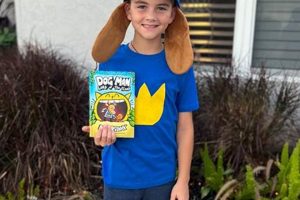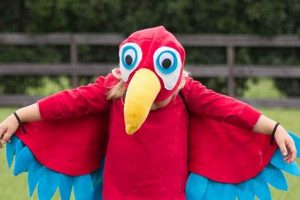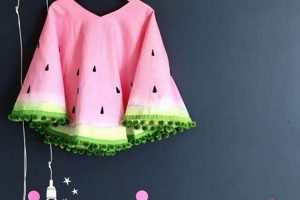Creating personalized Star Wars-themed attire represents an intersection of fandom, resourcefulness, and creative expression. This activity involves designing and constructing outfits inspired by characters and elements from the Star Wars universe, typically using readily available materials and self-taught techniques. An example includes fashioning a Jedi robe from repurposed fabric or constructing a Stormtrooper helmet using cardboard and paint.
The practice of crafting these ensembles allows individuals to connect more deeply with the Star Wars narrative, fostering a sense of ownership and personalization absent from commercially produced items. It offers a cost-effective alternative to purchasing licensed costumes, allowing enthusiasts to participate in events, conventions, and celebrations without significant financial investment. Historically, the creation of such homemade garments has been a hallmark of fan culture, demonstrating dedication and ingenuity.
The following article will delve into various aspects of creating such custom-made apparel. It will cover sourcing appropriate materials, adapting patterns, and employing techniques to achieve authentic and recognizable representations of iconic characters and designs from a galaxy far, far away.
Creating Authentic Star Wars-Inspired Garments
The following guidance provides key strategies for developing compelling and recognizable Star Wars-themed outfits through do-it-yourself methods. Attention to detail and resourcefulness are crucial for successful implementation.
Tip 1: Reference Original Source Material: Meticulously examine images and descriptions of characters and costumes from Star Wars films, television series, and related media. Accurate representation relies on understanding the nuances of design, color, and texture.
Tip 2: Prioritize Fabric Selection: Choose fabrics that closely resemble those used in the original costumes. For example, heavy linen or canvas can emulate the texture of Jedi robes, while pleather or vinyl can simulate the armor of Imperial officers or bounty hunters.
Tip 3: Utilize Existing Patterns as a Base: Modify pre-existing sewing patterns for robes, tunics, and pants to match the specific silhouettes of Star Wars garments. This approach saves time and ensures a structurally sound foundation for the costume.
Tip 4: Employ Weathering Techniques: Add subtle distressing effects to clothing and accessories to convey a sense of wear and tear, reflecting the lived-in aesthetic of the Star Wars universe. This can be achieved through techniques such as sanding, staining, or applying diluted paint.
Tip 5: Fabricate Accessories with Durable Materials: Construct lightsabers, blasters, and other props using sturdy materials like PVC pipe, wood, or 3D-printed components. Ensure the accessories are appropriately sized and proportioned to complement the costume.
Tip 6: Consider Comfort and Functionality: Design the costume with wearability in mind, especially if it will be worn for extended periods at conventions or events. Allow for ease of movement and ventilation to prevent overheating.
Tip 7: Accessorize Strategically: The addition of accurate belts, pouches, and boots significantly enhances the overall authenticity of a Star Wars-inspired outfit. Source these accessories from surplus stores, online retailers, or craft them from scratch.
By adhering to these guidelines, individuals can produce impressive and recognizable Star Wars-inspired attire that captures the essence of the franchise without relying on costly pre-made options.
The subsequent sections will explore specific character costume builds and offer detailed instructions for creating key elements of those outfits.
1. Character selection impacts design.
The process of designing a Star Wars-themed outfit is fundamentally dictated by the chosen character. This selection serves as the primary determinant for all subsequent design choices, influencing material acquisition, pattern modification, prop fabrication, and overall aesthetic. For instance, deciding to create a Boba Fett costume necessitates sourcing appropriate armor plating materials, replicating the character’s unique helmet design, and incorporating weathered visual elements. Conversely, choosing to construct a Padm Amidala gown requires the acquisition of flowing fabrics, precise pattern drafting to match the elaborate designs, and delicate embellishments. Thus, the initial character choice acts as the blueprint guiding the entire undertaking.
The impact of character selection extends to practical considerations. A complex character such as a Clone Trooper will require a significant investment of time and resources for armor construction, painting, and assembly. Simpler characters, like a Jawa, can be achieved with readily available materials and minimal sewing skills. Furthermore, specific character designs present unique challenges. Darth Vader, while iconic, requires attention to breathability within the helmet and mobility within the suit. Accurately representing a Wookiee necessitates advanced fur-working techniques and consideration of weight distribution for the costume’s wearer. Consequently, an informed character selection should reflect an individual’s skill level, available resources, and desired level of complexity.
In summary, character selection exerts a profound influence on every facet of do-it-yourself Star Wars costume creation. The chosen character directly dictates material requirements, design complexities, construction techniques, and overall logistical considerations. Understanding this fundamental relationship is paramount for ensuring a successful and satisfying costume creation experience, aligning expectations with achievable outcomes within a given timeframe and budget.
2. Material choice defines authenticity.
Within the realm of self-made Star Wars-themed garments, the selection of materials exerts a significant influence on the perceived authenticity of the final product. This relationship stems from the visual and tactile properties inherent in different fabrics, textures, and components. The choice to use materials that closely resemble those hypothetically present in the Star Wars universe directly impacts the level of immersion and believability achieved by the completed costume. For example, utilizing burlap or heavy linen to simulate the rustic texture of a Jedi robe contributes significantly to the costume’s realistic appearance, whereas using a modern, synthetic fabric detracts from the desired effect. Similarly, employing metallic spray paint on plastic components intended to represent stormtrooper armor offers a greater sense of verisimilitude than simply leaving the plastic unadorned.
The correlation between material authenticity an
d costume credibility extends beyond mere aesthetics. The performance characteristics of chosen materials impact both the comfort and the durability of the final product. Opting for breathable cotton or linen under layers of armor enhances wearer comfort during extended use. Similarly, selecting robust materials for structural components ensures the costume can withstand the rigors of conventions, parades, or other events. Consider the choice between crafting a lightsaber hilt from wood versus flimsy plastic. The wooden hilt, although potentially more challenging to work with, offers a greater sense of weight, durability, and tactile authenticity that enhances the overall user experience. Conversely, reliance on inappropriate material may result in discomfort, rapid degradation, and an overall diminished sense of realism.
In summation, material selection represents a crucial element in the successful creation of do-it-yourself Star Wars attire. The accuracy of chosen materials directly affects the visual authenticity, tactile feel, durability, and wearer experience of the costume. While resourcefulness and affordability are important considerations, prioritizing materials that closely align with the visual language of the Star Wars universe significantly enhances the overall impact and credibility of the finished product. Overcoming the challenge of sourcing suitable materials frequently requires ingenuity, repurposing readily available items, and creatively adapting materials to achieve the desired aesthetic.
3. Pattern adaptation ensures fit.
Within the context of creating custom Star Wars-themed outfits, pattern adaptation plays a pivotal role in achieving a well-fitting and visually accurate representation of the desired character or garment. The human form rarely conforms perfectly to standard pattern sizes, necessitating alterations to ensure both comfort and aesthetic fidelity to the source material.
- Accounting for Body Measurements
Existing commercial patterns are often based on generalized body measurements, which may not accurately reflect the wearer’s unique proportions. Adjustments to the pattern’s length, width, and shaping are crucial for accommodating variations in torso length, shoulder width, and other individual characteristics. Failing to account for these discrepancies results in ill-fitting garments that detract from the overall impact of the costume.
- Adapting to Costume Silhouettes
Star Wars costumes frequently feature unique silhouettes and design elements that deviate significantly from standard clothing patterns. Creating a Jedi robe, for example, requires modifying a basic robe pattern to incorporate the characteristic wide sleeves and flowing drape. Similarly, constructing armor pieces necessitates adapting patterns to create accurate shapes and contours that conform to the wearer’s body while maintaining the intended appearance.
- Material Considerations in Pattern Adjustment
The type of material used in a Star Wars costume influences the necessary pattern adaptations. Stiff or non-stretch fabrics, such as those used for armor components, require more precise pattern fitting to allow for movement and prevent discomfort. Conversely, stretch fabrics, such as those used for body suits, may necessitate smaller pattern sizes to account for the fabric’s ability to conform to the body. Understanding the properties of the chosen material is crucial for accurate pattern adjustment.
- Iterative Fitting and Refinement
Achieving a perfect fit often requires an iterative process of fitting and refinement. A muslin mock-up, constructed from inexpensive fabric, allows for preliminary adjustments to the pattern before cutting into the final material. This process enables the identification and correction of fitting issues, such as gaping necklines, tight armholes, or uneven hemlines. Multiple fitting sessions may be necessary to achieve the desired level of fit and comfort.
The meticulous process of pattern adaptation ensures that a self-made Star Wars outfit transcends a mere imitation and becomes a tailored representation of the source material, enhancing both the wearer’s experience and the overall visual impact. This attention to detail differentiates professionally crafted costumes from amateur efforts, underscoring the importance of pattern modification in achieving a truly compelling result. Neglecting pattern adaptation compromises both fit and form, impacting the overall success in replicating iconic Star Wars character designs.
4. Prop fabrication enhances immersion.
Within the creation of homemade Star Wars-themed attire, the fabrication of props serves as a critical element in amplifying the immersive quality of the experience. The meticulous crafting of lightsabers, blasters, and other iconic accessories elevates the costume from a simple imitation to a more complete and convincing representation of a character or role within the Star Wars universe. The authenticity of these props significantly influences the audience’s perception and the wearer’s engagement with the character.
- Tangible Representation of Identity
Props function as tangible extensions of a character’s identity, offering visual cues that immediately establish a connection to the Star Wars narrative. A carefully constructed lightsaber instantly signifies a Jedi or Sith, while a blaster pistol identifies a character aligned with the Rebel Alliance or the Galactic Empire. The presence of these props provides immediate recognition and context, enhancing the immersive quality of the costume.
- Enhancement of Role-Playing Opportunities
Self-made props facilitate deeper engagement in role-playing scenarios during conventions, events, and personal enactments. A realistically crafted blaster allows the wearer to adopt the stance and mannerisms of a bounty hunter, while a detailed communicator enables simulated interactions with other characters. The tangible presence of these items fuels imaginative play and fosters a more profound connection to the Star Wars universe.
- Attention to Detail Amplifies Realism
The level of detail incorporated into prop fabrication directly correlates with the degree of realism achieved. Accurate weathering techniques, meticulous replication of design elements, and the use of appropriate materials contribute to a sense of verisimilitude that enhances the immersive experience. A lightsaber hilt crafted from metal components and featuring accurate switch details provides a more convincing impression than one constructed from simple plastic tubing.
- Creation of a Sensory Connection
Props engage multiple senses, further contributing to the immersive quality of a self-made Star Wars costume. The weight of a blaster pistol in the hand, the sound of a lightsaber activating, or the tactile feel of a Wookiee bowcaster trigger generate a sensory connection to the Star Wars universe that extends beyond visual representation. The incorporation of these sensory elements intensifies the overall feeling of immersion.
In conclusion, the fabrication of props represents an integral component of the do-it-yourself Star Wars costume experience. The presence of accurate and well-crafted prop
s elevates the costume beyond a superficial representation, fostering a deeper connection to the Star Wars narrative and enhancing the wearer’s and the audience’s sense of immersion within that universe. The decision to invest time and effort into prop fabrication underscores a commitment to authenticity and detail, ultimately resulting in a more compelling and engaging costume experience.
5. Wearability affects practicality.
The ease with which a self-made Star Wars-themed outfit can be worn significantly impacts its overall practicality. Costume design must prioritize wearer comfort and functionality. An elaborately designed, visually accurate costume is rendered impractical if it inhibits movement, causes overheating, or is unduly cumbersome. The intended use of the garment directly influences the design choices made to balance visual fidelity with wearability. For example, a screen-accurate recreation of Darth Vader’s armor may be unsuitable for extended wear at an outdoor convention due to heat retention and limited mobility. Conversely, a simpler Jedi tunic, while less visually striking, offers greater comfort and freedom of movement, enhancing its practicality for various activities.
The interplay between wearability and practicality necessitates careful consideration of material selection, construction techniques, and design modifications. Breathable fabrics, such as linen or cotton, are often preferred for under layers to mitigate overheating. Articulated joints in armor pieces improve mobility, while strategically placed ventilation can enhance airflow. Furthermore, the weight and distribution of costume components must be carefully managed to minimize strain on the wearer. A heavy helmet, for instance, may require a supporting harness to distribute the load and prevent neck fatigue. Ignoring these factors can transform a potentially enjoyable costume experience into an uncomfortable and ultimately impractical endeavor. Real-world examples include individuals abandoning elaborate costumes mid-convention due to discomfort or modifying designs to improve wearability after initial trials.
In summary, the practicality of a homemade Star Wars-themed outfit is inextricably linked to its wearability. Prioritizing comfort, functionality, and ease of movement ensures the costume can be enjoyed for extended periods without compromising the wearer’s well-being or hindering their participation in activities. Understanding this relationship allows creators to make informed design choices, balancing visual accuracy with practical considerations to achieve a successful and satisfying costume experience. Challenges remain in replicating complex designs while maintaining optimal wearability, requiring ingenuity and a willingness to adapt to limitations.
Frequently Asked Questions Regarding Self-Made Star Wars Garments
This section addresses common inquiries and clarifies misconceptions surrounding the creation of do-it-yourself Star Wars costumes. The following information aims to provide factual guidance for individuals engaging in this creative pursuit.
Question 1: Is prior sewing experience necessary to construct a credible Star Wars costume?
While advanced sewing skills enhance the potential complexity and detail achievable, basic sewing knowledge suffices for many simpler costume designs. Resources such as online tutorials and readily available patterns offer accessible guidance for individuals with limited experience. Simpler projects, such as Jedi robes or basic tunics, require minimal sewing proficiency.
Question 2: How can accurate fabric colors and textures be achieved without purchasing expensive materials?
Resourcefulness in material sourcing is key. Repurposing existing fabrics, utilizing dye techniques to alter colors, and employing weathering methods to add texture contribute to the authenticity of a costume without incurring significant expense. Thrift stores and online marketplaces offer affordable alternatives to specialized fabric retailers.
Question 3: What are the most cost-effective methods for fabricating prop weapons and accessories?
Common household items and readily available materials such as PVC pipes, cardboard, and craft foam provide economical alternatives to purchasing pre-made props. These materials can be shaped, painted, and assembled to create convincing replicas of lightsabers, blasters, and other iconic accessories. Online tutorials offer detailed instructions for prop fabrication techniques.
Question 4: How can costume comfort and mobility be maximized while maintaining visual accuracy?
Prioritizing breathable fabrics for under layers, incorporating articulated joints into armor components, and carefully managing the weight distribution of costume elements enhance comfort and mobility without compromising visual fidelity. Strategic modifications to pattern designs accommodate ease of movement and prevent overheating.
Question 5: What ethical considerations should be observed when creating a self-made Star Wars costume?
Respect for intellectual property rights is paramount. Avoid the unauthorized reproduction and sale of copyrighted designs or patterns. Furthermore, be mindful of cultural appropriation and avoid incorporating elements that could be considered offensive or disrespectful.
Question 6: How can a self-made Star Wars costume be safely transported and stored?
Protective garment bags, sturdy storage containers, and careful handling techniques minimize the risk of damage during transport and storage. Delicate costume components should be individually wrapped and supported to prevent crushing or distortion. Proper storage conditions, such as a cool, dry environment, prolong the lifespan of the costume.
In conclusion, crafting a Star Wars-themed outfit involves navigating a balance between accuracy, cost-effectiveness, and practicality. Adherence to these guidelines facilitates a positive and rewarding costume creation experience.
The following section will explore specific character costume builds and offer detailed instructions for creating key elements of those outfits.
diy star wars costume
The preceding analysis has explored the multifaceted nature of designing and creating personalized Star Wars-themed attire. Key considerations encompass character selection’s influence on design, the vital role of material choice in establishing authenticity, the importance of pattern adaptation for ensuring proper fit, the contribution of prop fabrication to immersive experiences, and the critical balance between wearability and practicality. A comprehensive understanding of these elements facilitates the creation of compelling and recognizable garments inspired by the Star Wars universe.
The pursuit of crafting individualized Star Wars costumes offers a unique intersection of fandom, creativity, and resourcefulness. This activity not only permits enthusiasts to engage more deeply with the source material, but also fosters a sense of personal expression and ingenuity. The enduring appeal of the Star Wars saga suggests that the creation of such fan-made garments will persist as a testament to the franchise’s cultural impact and the enduring spirit of its dedicated followers.







